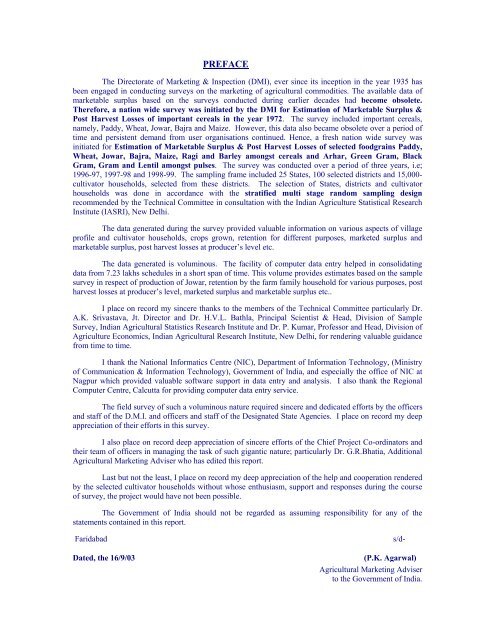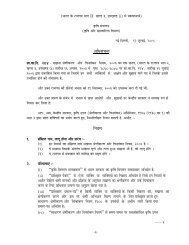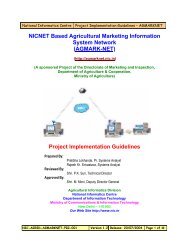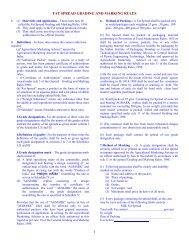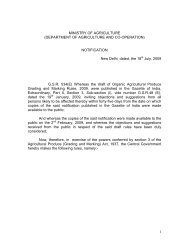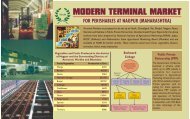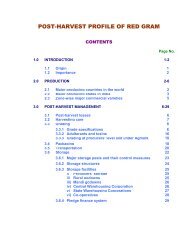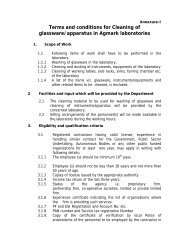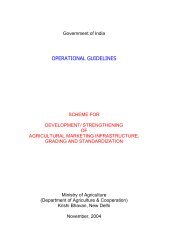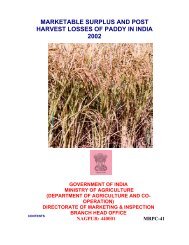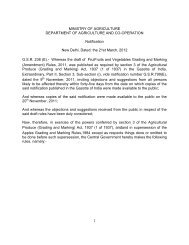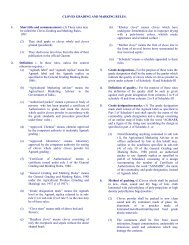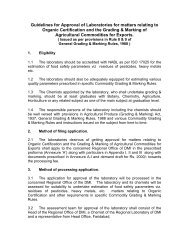Marketed Surplus and Post-harvest Losses of Jowar - Agmarknet
Marketed Surplus and Post-harvest Losses of Jowar - Agmarknet
Marketed Surplus and Post-harvest Losses of Jowar - Agmarknet
Create successful ePaper yourself
Turn your PDF publications into a flip-book with our unique Google optimized e-Paper software.
PREFACE<br />
The Directorate <strong>of</strong> Marketing & Inspection (DMI), ever since its inception in the year 1935 has<br />
been engaged in conducting surveys on the marketing <strong>of</strong> agricultural commodities. The available data <strong>of</strong><br />
marketable surplus based on the surveys conducted during earlier decades had become obsolete.<br />
Therefore, a nation wide survey was initiated by the DMI for Estimation <strong>of</strong> Marketable <strong>Surplus</strong> &<br />
<strong>Post</strong> Harvest <strong>Losses</strong> <strong>of</strong> important cereals in the year 1972. The survey included important cereals,<br />
namely, Paddy, Wheat, <strong>Jowar</strong>, Bajra <strong>and</strong> Maize. However, this data also became obsolete over a period <strong>of</strong><br />
time <strong>and</strong> persistent dem<strong>and</strong> from user organisations continued. Hence, a fresh nation wide survey was<br />
initiated for Estimation <strong>of</strong> Marketable <strong>Surplus</strong> & <strong>Post</strong> Harvest <strong>Losses</strong> <strong>of</strong> selected foodgrains Paddy,<br />
Wheat, <strong>Jowar</strong>, Bajra, Maize, Ragi <strong>and</strong> Barley amongst cereals <strong>and</strong> Arhar, Green Gram, Black<br />
Gram, Gram <strong>and</strong> Lentil amongst pulses. The survey was conducted over a period <strong>of</strong> three years, i.e;<br />
1996-97, 1997-98 <strong>and</strong> 1998-99. The sampling frame included 25 States, 100 selected districts <strong>and</strong> 15,000cultivator<br />
households, selected from these districts. The selection <strong>of</strong> States, districts <strong>and</strong> cultivator<br />
households was done in accordance with the stratified multi stage r<strong>and</strong>om sampling design<br />
recommended by the Technical Committee in consultation with the Indian Agriculture Statistical Research<br />
Institute (IASRI), New Delhi.<br />
The data generated during the survey provided valuable information on various aspects <strong>of</strong> village<br />
pr<strong>of</strong>ile <strong>and</strong> cultivator households, crops grown, retention for different purposes, marketed surplus <strong>and</strong><br />
marketable surplus, post <strong>harvest</strong> losses at producer’s level etc.<br />
The data generated is voluminous. The facility <strong>of</strong> computer data entry helped in consolidating<br />
data from 7.23 lakhs schedules in a short span <strong>of</strong> time. This volume provides estimates based on the sample<br />
survey in respect <strong>of</strong> production <strong>of</strong> <strong>Jowar</strong>, retention by the farm family household for various purposes, post<br />
<strong>harvest</strong> losses at producer’s level, marketed surplus <strong>and</strong> marketable surplus etc..<br />
I place on record my sincere thanks to the members <strong>of</strong> the Technical Committee particularly Dr.<br />
A.K. Srivastava, Jt. Director <strong>and</strong> Dr. H.V.L. Bathla, Principal Scientist & Head, Division <strong>of</strong> Sample<br />
Survey, Indian Agricultural Statistics Research Institute <strong>and</strong> Dr. P. Kumar, Pr<strong>of</strong>essor <strong>and</strong> Head, Division <strong>of</strong><br />
Agriculture Economics, Indian Agricultural Research Institute, New Delhi, for rendering valuable guidance<br />
from time to time.<br />
I thank the National Informatics Centre (NIC), Department <strong>of</strong> Information Technology, (Ministry<br />
<strong>of</strong> Communication & Information Technology), Government <strong>of</strong> India, <strong>and</strong> especially the <strong>of</strong>fice <strong>of</strong> NIC at<br />
Nagpur which provided valuable s<strong>of</strong>tware support in data entry <strong>and</strong> analysis. I also thank the Regional<br />
Computer Centre, Calcutta for providing computer data entry service.<br />
The field survey <strong>of</strong> such a voluminous nature required sincere <strong>and</strong> dedicated efforts by the <strong>of</strong>ficers<br />
<strong>and</strong> staff <strong>of</strong> the D.M.I. <strong>and</strong> <strong>of</strong>ficers <strong>and</strong> staff <strong>of</strong> the Designated State Agencies. I place on record my deep<br />
appreciation <strong>of</strong> their efforts in this survey.<br />
I also place on record deep appreciation <strong>of</strong> sincere efforts <strong>of</strong> the Chief Project Co-ordinators <strong>and</strong><br />
their team <strong>of</strong> <strong>of</strong>ficers in managing the task <strong>of</strong> such gigantic nature; particularly Dr. G.R.Bhatia, Additional<br />
Agricultural Marketing Adviser who has edited this report.<br />
Last but not the least, I place on record my deep appreciation <strong>of</strong> the help <strong>and</strong> cooperation rendered<br />
by the selected cultivator households without whose enthusiasm, support <strong>and</strong> responses during the course<br />
<strong>of</strong> survey, the project would have not been possible.<br />
The Government <strong>of</strong> India should not be regarded as assuming responsibility for any <strong>of</strong> the<br />
statements contained in this report.<br />
Faridabad s/d-<br />
Dated, the 16/9/03 (P.K. Agarwal)<br />
Agricultural Marketing Adviser<br />
to the Government <strong>of</strong> India.


